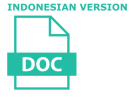Women’s Image as Presented in Vitamin Drink’s Commercials: Semiotics Analysis on YOU C-1000 and Hemaviton C1000
Amanah Risaningtyas(1*), Wahyu Kartika Wienanda(2)
(1) Gadjah Mada University
(2) Universitas Gadjah Mada
(*) Corresponding Author
Abstract
Several studies have identified women's image in beverage advertisements, but there has been not much research into the women’s image presented in vitamin drink commercials along with their slogans. This study focuses on an analysis of verbal and non-verbal signs of 2 vitamin drink commercials, namely YOU C1000 and Hemaviton C1000, from YouTube. Qualitative content analysis based on Peirce’s (1940) semiotics theory was used to analyse the verbal and non-verbal signs presented in the commercials, while the image of women proposed by Hung & Li (2006) was used to identify women’s image in the commercials. The findings suggest that in general, the commercials have tried to break the common traditional stereotypes of women’s image, even though some parts were still a bit stereotypical. The most common women’s image shown in the video is ‘a strong woman’. Moreover, the slogans of YOU C1000 and Hemaviton C1000 are trying to show that women can also do outdoor activities. The finding indicates that there is an attempt to change the way of presenting women in today’s advertisements.
Keywords
Full Text:
PDFReferences
Abdi, S., & Irandoust, A. (2013). The importance of advertising slogans and their proper designing in brand equity. International Journal of Organizational Leadership, 2(2), 62–69. https://doi.org/10.33844/ijol.2013.60321
Amelia, M. (2015). Identitas perempuan dalam iklan kopi luwak white koffie. Commonline, 4(1), 250–263. http://journal.unair.ac.id/download-fullpapers-comme709e41756full.pdf
Ballast, D. K. (2002). Intertior design reference manual. Professional Publications Inc.
Birren, F. (1980). Color in your world. MacMillan Publishing.
Chandler, D. (2007). Semiotics The Basics (2nd ed.). Routledge.
Clarke, T., & Costall, A. (2008). The emotional connotations of color: A qualitative investigation. Color Research and Application, 33(5), 406–410. https://doi.org/10.1002/col.20435
Doring, N., Reif, A., & Poeschl, S. (2016). How gender-stereotypical are selfies? A content analysis and comparison with magazine adverts. Computers in Human Behavior, 55, 955–962. https://doi.org/10.1016/j.chb.2015.10.001
Ege, A. G. A. (2015). Makna kecantikan perempuan dalam iklan televisi YOU C1000 Vitamin ‘Batik’ – Leila Lopes [Widya Mandala Catholic University Surabaya]. http://repository.wima.ac.id/id/eprint/6693/
Eisend, M. (2010). A meta-analysis of gender roles in advertising. Journal of the Academy of Marketing Science, 38, 418–440. https://doi.org/10.1007/s11747-009-0181-x
Eisend, M. (2019). Gender Roles. Journal of Advertising, 48(1), 72–80. https://doi.org/10.1080/00913367.2019.1566103
Fardiana, O. I. (2014). MITOS KECANTIKAN PEREMPUAN MUSLIM (Studi Diskursif dalam Blog Fashion Muslim) [Universitas Airlangga]. http://repository.unair.ac.id/id/eprint/16589
Farris, N. (2014). The proof is in the pudding: gender specific stereotypes in television advertisements. In D. N. Farris, M. A. Davis, & D. R. Compton (Eds.), Illuminating how identities, stereotypes, and inequalities matter through gender studies (pp. 71–81). Springer.
Furnham, A., & Paltzer, S. (2010). The portrayal of men and women in television advertisements: An updated review of 30 studies published since 2000. Scandinavian Journal of Psychology, 51(3), 216–236. https://doi.org/10.1111/j.1467-9450.2009.00772.x
Hung, K., & Li, S. Y. (2006). Images of the Contemporary Woman in Advertising in China: A Content Analysis. Journal of International Consumer Marketing, 19(2), 7–28. https://doi.org/10.1300/J046v19n02_02
Idrus, M. (2012). Pendidikan Karakter pada Keluarga Jawa. Jurnal Pendidikan Karakter, 3(2), 118–130. https://doi.org/10.21831/jpk.v0i2.1297
Kim, K., & Lowry, D. T. (2005). Television Commercials as a Lagging Social Indicator: Gender Role Stereotypes in Korean Television Advertising. Sex Roles, 53, 901–910. https://doi.org/10.1007/s11199-005-8307-1
Kitsa, M., & Mudra, I. (2020). Gender stereotypes of women in television advertising in Ukraine. Feminist Media Studies, 20(3), 381–397. https://doi.org/10.1080/14680777.2019.1574857
Kordrostami, M., & Laczniak, R. N. (2021). Female power portrayals in advertising. International Journal of Advertising. https://doi.org/10.1080/02650487.2021.1998878
Lazfihma. (2014). Analisis Gaya Bahasa dalam Slogan Iklan Minuman di Televisi [Universitas Negeri Yogyakarta]. https://eprints.uny.ac.id/17939/
Peirce, C. S. (1940). Philosophical Writings of Peirce. Dover Publications.
Purnamawati, A. (2012). Media, Perempuan, dan Kemandirian. Observasi, 10(1), 57–64. https://jurnal.kominfo.go.id/index.php/observasi/article/view/77/70
Ratna, M. P. (2014). Gerak Tangan sebagai Isyarat dalam Masyarakat Jepang dan Masyarakat Indonesia. Izumi, 3(1), 34–41. https://doi.org/10.14710/izumi.3.1.34-41
Rini, D. P. (2010). Membongkar makna dibalik representasi citra perempuan dalam iklan kecantikan. Universitas Gadjah Mada.
Rose, J., Mackey-Kallis, S., Shyles, L., Barry, K., Biagini, D., Hart, C., & Jack, L. (2012). Face it: The Impact of Gender on Social Media Images. Communication Quarterly, 60(5), 588–607. https://doi.org/10.1080/01463373.2012.725005
Subagja, R. N. (2017). Makna Iklan Televisi Extra Joss Blend Versi “Laki Kalah sama Pelangi” (analisis Semiotika Jhon Fiske. E-Proceeding of Management, 4(3), 3032–3046. https://openlibrarypublications.telkomuniversity.ac.id/index.php/management/article/view/5008
Sung, Y., & Kim, S. (2013). The Effects of Colors on Brand Personality in Advertising. The Korean Journal of Advertising, 2(2), 85–115. https://doi.org/10.14377/JAPR.2013.9.30.85
Tartaglia, S., & Rollero, C. (2015). Gender Stereotyping in Newspaper Advertisements: A Cross-Cultural Study. Journal of Cross-Cultural Psychology, 46(8), 1103–1109. https://doi.org/10.1177/0022022115597068
Tsichla, E. (2020). The Changing Roles of Gender in Advertising: Past, Present, and Future. Contemporary Southeastern Europe, 7(2), 28–44. https://doi.org/10.25364/02.7:2020.2.3
Wasista, R. M. P. (2012). Representasi Kecantikan Perempuan Postcolonialdalam Iklan (Representasi Kecantikan Perempuanpostcolonialdalam Iklan Tv You C 1000 Mg Periode 2004-2011) [Universitas Muhammadiyah Surakarta]. http://eprints.ums.ac.id/20622/
Wood, J. T. (1994). Gendered media: The influence of media on views of gender. In Gendered Lives: Communication, Gender, and Culture (pp. 231–244). Wadsworth Publishing.
Yuliang, C. (2010). A Semiotic Analysis of Female Images in Chinese Women’s Magazines. Social Sciences in China, 31(2), 179–193. https://doi.org/10.1080/02529201003794957
Zotos, Y. C., & Tsichla, E. (2014). Female Stereotypes in Print Advertising: A Retrospective Analysis. Procedia - Social and Behavioral Sciences, 148, 446–454. https://doi.org/10.1016/j.sbspro.2014.07.064
Article Metrics
Refbacks
- There are currently no refbacks.
Copyright (c) 2021 The Author(s)

This work is licensed under a Creative Commons Attribution-ShareAlike 4.0 International License.







